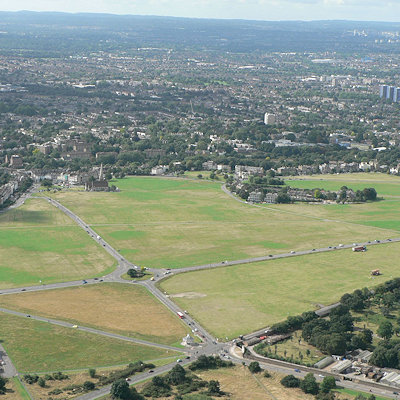
Like us on Facebook
PLACE NAMES


 
|
|
Blackheath
|

|
|
 | Pepys House, 2 Cutty Sark Gardens, Greenwich - 0870 608 2000
St. Paul's Churchyard, London - 020 7332 3456
tic@visitgreenwich.org.uk
|
Blackheath is an area of south-east London, divided between the Royal Borough of Greenwich and the London Borough of Lewisham, located east of the town of Lewisham, and south of the town of Greenwich. It is notable for its traditional pubs, village-y feel, and extensively large green space.
The name is recorded in 1166 as Blachehedfeld and means the "dark coloured heathland". It is formed from the Old English 'blæc' (bare or barren) and 'hæth' and refers to the open space that was the meeting place of the ancient hundred of Blackheath. The name was later applied to the Victorian suburb that developed in the 19th century and was extended to the areas known as Blackheath Park and Blackheath Vale. There is no connection whatsoever with the colour black. In fact the Old English 'blæc' is where we get the modern word "bleach".
An urban myth is that Blackheath was associated with the 1665 Plague or the Black Death of the mid-14th century. The idea that Blackheath got its name from its use as a burial pit goes all the way back to the medieval period, when it was almost certainly used for the disposal of the dead during the Black Death. Virtually every part of London has a local tradition about plague pits under, say, a local school or shop. Certainly they were very common. The sheer number of bodies meant that the traditional churchyards became, as one contemporary put it, 'overstuft' very quickly.
During the seventeenth century Blackheath was, along with Hounslow Heath, a common assembly point for English Armies. In 1673 the Blackheath Army was assembled under Marshal Schomberg to serve in the Third Anglo-Dutch War.
The Roman road that later became known as Watling Street crosses the northern edge of Blackheath (almost in line with the A2), probably heading for the mouth of Deptford Creek, rather than for Deptford Bridge like the modern A2. Before the development of Greenwich palace by the Tudors, the Plantagenet palace was located at Eltham Palace to the southeast of the heath and Watling Street and used as a royal residence from the 14th to the 16th century.
Blackheath was a rallying point for Wat Tyler's Peasants' Revolt of 1381, and for Jack Cade's Kentish rebellion in 1450. Wat Tyler is remembered by Wat Tyler Road on the heath, and Jack Cade by Cade Road near the heath. After pitching camp on Blackheath, Cornish rebels were defeated in the Battle of Deptford Bridge (sometimes called the Battle of Blackheath), just to the west, on 17 June 1497.
With Watling Street carrying stagecoaches across the heath, en route to north Kent and the Channel ports, it was also a notorious haunt of highwaymen during the 17th and 18th centuries. As reported in Edward Walford's Old and New London (1878), "In past times it was planted with gibbets, on which the bleaching bones of men who had dared to ask for some extension of liberty, or who doubted the infallibility of kings, were left year after year to dangle in the wind." In 1909 Blackheath had a local branch of the London Society for Women's Suffrage.
The Vanbrugh Pits are on the north-east part of the heath. The site of old gravel workings, Vanbrugh Pits have long been reclaimed by nature and form one of the more attractive parts of the generally rather flat Blackheath. It is particularly attractive in spring when the extensive gorse blossoms. The pits are named after Sir John Vanbrugh, architect of Blenheim Palace and Castle Howard, who had a house nearby, adjacent to Greenwich Park, now called Vanbrugh Castle. 'Mince Pie House' built for his family, survived until 1911.
|
 Feel free to Email me any additions or corrections Feel free to Email me any additions or corrections
LINKS AVAILABLE TO YOUR SITE
| |





